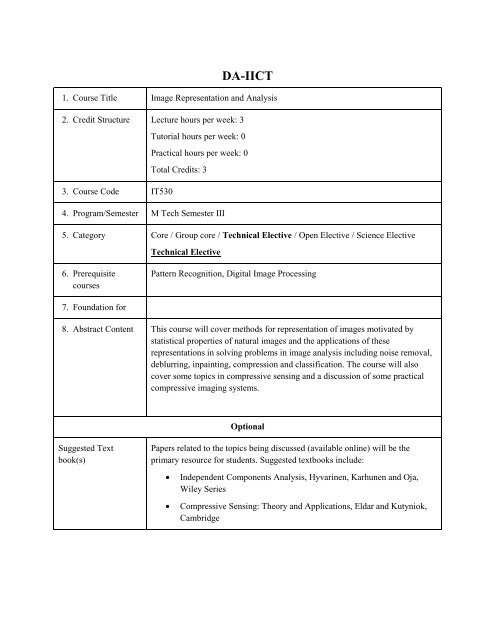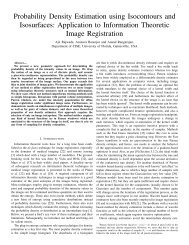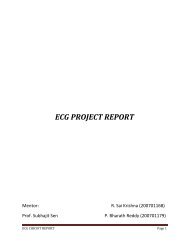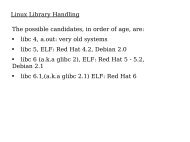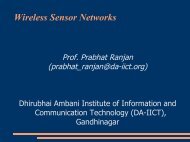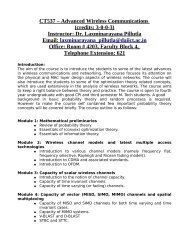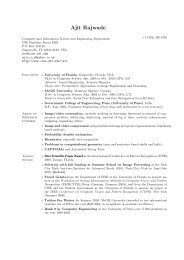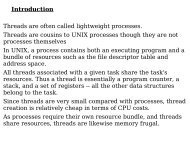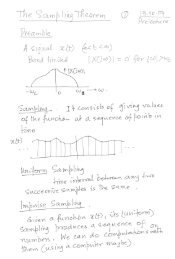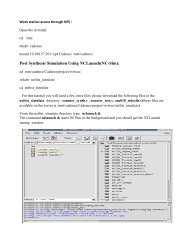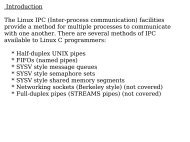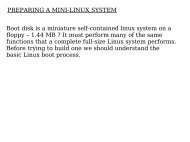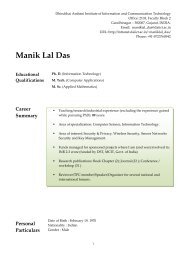here (.pdf) - DAIICT Intranet
here (.pdf) - DAIICT Intranet
here (.pdf) - DAIICT Intranet
You also want an ePaper? Increase the reach of your titles
YUMPU automatically turns print PDFs into web optimized ePapers that Google loves.
DA-IICT<br />
1. Course Title Image Representation and Analysis<br />
2. Credit Structure Lecture hours per week: 3<br />
3. Course Code IT530<br />
Tutorial hours per week: 0<br />
Practical hours per week: 0<br />
Total Credits: 3<br />
4. Program/Semester M Tech Semester III<br />
5. Category Core / Group core / Technical Elective / Open Elective / Science Elective<br />
6. Prerequisite<br />
courses<br />
7. Foundation for<br />
Technical Elective<br />
Pattern Recognition, Digital Image Processing<br />
8. Abstract Content This course will cover methods for representation of images motivated by<br />
statistical properties of natural images and the applications of these<br />
representations in solving problems in image analysis including noise removal,<br />
deblurring, inpainting, compression and classification. The course will also<br />
cover some topics in compressive sensing and a discussion of some practical<br />
compressive imaging systems.<br />
Suggested Text<br />
book(s)<br />
Optional<br />
Papers related to the topics being discussed (available online) will be the<br />
primary resource for students. Suggested textbooks include:<br />
Independent Components Analysis, Hyvarinen, Karhunen and Oja,<br />
Wiley Series<br />
Compressive Sensing: Theory and Applications, Eldar and Kutyniok,<br />
Cambridge
Detailed Course Contents<br />
Topic Name Content (2 -3 lines per 4 – 6 lectures) No. of<br />
lectures<br />
(tentati<br />
ve)<br />
Statistics of natural<br />
images<br />
Statistics of image Fourier or wavelet coefficients, relationship<br />
between Fourier bases and principal components of natural images<br />
Readings:<br />
(i) Huang and Mumford, “Statistics of Natural Images and Models”<br />
(ii) Hyvarinen et al, “Independent Components Analysis” (book)<br />
Sparse coding Sparse coding of images with applications to image denoising<br />
Readings:<br />
(i) Hyvarinen et al, “Image Denoising by Sparse Code Shrinkage”<br />
(ii) Rajashekhar and Simoncelli, “Multiscale denoising of<br />
photographic images”<br />
Dictionary learning Dictionary learning for efficient image representation: applications<br />
in compression, deblurring, inpainting and classification<br />
Readings:<br />
(i) Lewicki and Sejnowski, “Learning Overcomplete<br />
Representations”<br />
(ii) Aharon et al, “KSVD-An Algorithm for Designing of<br />
Overcomplete Dictionaries for Sparse Representation”<br />
(iii) Mairal et al, “Discriminative Sparse Image Models for Class-<br />
Specific Edge Detection and Image Interpretation”<br />
Compressive Sensing Overview of basic set of results, proof of one key result, examples<br />
of practical compressive imaging systems: Rice single-pixel<br />
camera, and time-domain coded multiplexing for compressive<br />
video<br />
Non-local selfsimilarity<br />
of images<br />
Non-local means, collective processing of image patches (spatially<br />
varying PCA, simultaneous sparse coding)<br />
3<br />
4<br />
5<br />
7<br />
3


